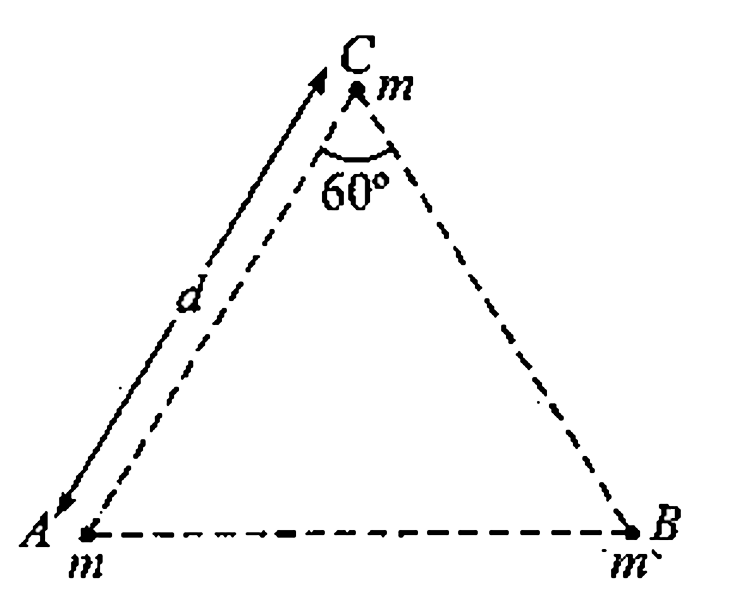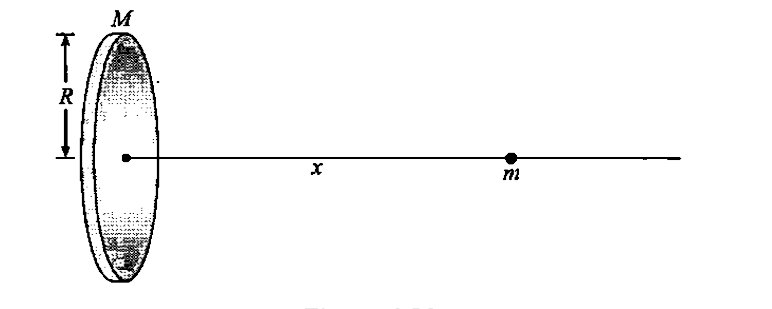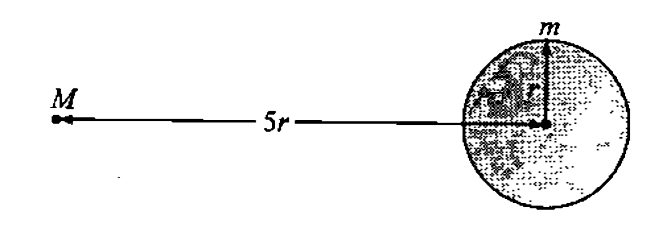Complete Solutions to Illustrative Example of chapter GRAVITATION of Class 11 book with complete answers and questions
| Class 11 | PHYSICS |
| Chapter | GRAVITATION |
| PHYSICS GALAXY | Illustrative Example |
| Number Of Questions | 54 |
| Academic Year | 2023-24 |
Three points A , B and C each of mass are placed in a line with AB=BC=d. Find the gravitational force on a fourth particle P of same mass placed at a distance d from the particle B on the perpendicular bisector of the line AC.
View SolutionFind the force of attraction on a particle of mass m placed at the centre of a quarter ring of mass mand radius R as shown in figure.

View SolutionTwo balls of mass m each are hung side by side by side by two long threads of equal length l. If the distance between upper ends is r, show that the distance r' between the centres of the ball is given by `g r'^(2)(r-r')=2l G m`
View SolutionA ring of radius R is made from a thin wire of radius r. If `rho` is the density of the material of wire then what will be the gravitational force exerted by the ring on the material particle of mass m placed on the axis of ring of ring at a distance x from its centre. Shown that the force will be maximum when `x=R//sqrt(2)` and the maximum value of force will be given as
`F_(max)=(4pi^(2)G r^(2)rhom)/((3)^(3//2)R^(2))`
View SolutionFind the distance of a point from the earth's centre where the resultant gravitational field due to the earth and the moon is zero. The mass of the earth is `6.0xx10^(24)kg` and that of the moon is `7.4xx10^(22)kg`. The distance between the earth and the moon is `4.0xx10^(5)km`.
View SolutionA uniform ring of mas m and radius a is placed directly above a uniform sphere of mass M and of equal radius. The centre of the ring is at a distance `sqrt3` a from the centre of the sphere. Find the gravitational force exerted by the sphere on the ring.
View SolutionFigure shows a spherical cavity inside a lead sphere. The surface of the cavity passes through the centre of the sphere and touches the right side of the sphere. The mass of the sphere before hollowing was `M`. With what gravitational force does the hollowed out lead sphere attract a particle of mass `m` that lies at a distance `d` from the centre of the lead sphere on the straight line connecting the centres of the spheres and of the cavity.

View SolutionA uniform solid sphere of mass M and radius a is surrounded symmetrically by a uniform thin spherical shell of equal mass and radius 2a. Find the gravitational field at a distance a). 3/2 a from the centre , b). 5/2 as from the centre.
View SolutionThe small dense stars rotate about their common centre of mass as a binary system, each with a period of `1` year. One star has mass double than that of the other, while mass of the lighter star is one-third the mass of the Sun. The distance between the two stars is `r` and the distance of the earth from the Sun is `R`, find the relation between `r` and `R`.
View SolutionCalculate mass of earth taking it to ne a sphere of radius 6400 km. given `g=9.8 m//s^(2)` and `G=6.67xx10^(-11)N m^(2)kg^(-2)`
View SolutionIf the radius of the earth were to shrink by one percent its mass remaining the same, the acceleration due to greavity on the earth's surface would
View SolutionAt what rate should the earth rotate so that the apparent g at the equator becomes zero? What will be the length of the day in this situation?
View SolutionTwo equal masses each in are hung from a balance whose scale pans differ in vertical height by `h`. The error in weighing in terms of density of the earth `rho` is
View SolutionCalculate the apparent weight of a body of mass m at a latitude `lambda` when it is moving with speed v on the surface of the earth from west to east at the same latitude.
View SolutionThree particle each of mass m are placed at the corners of an equilateral at the corners of an equilateral triangle of side d as shown in figure. Calculate (a) the potential energy of the system, (b) work done on this system if the side of the traingle is changed from d to 2d.

View SolutionTwo particles `m_(1)` and `m_(2)` are initially at rest at infinite distance. Find their relative velocity of approach due to gravitational attraction when their separation is d.
View SolutionTwo particles A and B of masses 1 kg and 2 kg respectively are kept 1 m apart and are released to move under mutual attraction. Find The speed A when that of B is 3.6 cm/hour. What is the separation between the particles at this instant?
View SolutionFind work done in shifting a body of mass m from a height h above the earth's surface to a height 2h above the earth's surface.
View SolutionA circular ring of mass M and radius R is placed in YZ plane with centre at origin. A particle of mass m is released from rest at a point x = 2R. Find the speed with which it will pass the centre of ring .
View SolutionFind the gravitational interaction energy of system consisting of a disc of mass M, radius R and a small mass m dituated at a distance x from disc centre on its axis as shown in figure.

View SolutionA small mass m is transferred from the centre of a hollow sphere of mass M to infinity. Find work done in the process. Compare this with the situation if instead of a hollow sphere, a solid sphere of same mass were there.
View SolutionGiven a thin homogenous disc of radius a and mass `m_(1)`. A particle of mass `m_(2)` is placed at a distance `l` from the disc on it's axis of symmetry. Initially both are motionless in free space but they ultimately collide because of gravitational attraction. find the relative velocity at the time of collision. assume `altlt1`.
View SolutionFigure. Shown a ring of mass `M_(1)` ans a sphere of mass `M_(2)` separated by a distance `sqrt(3)R`. A small object of mass m is displaced from A to B. Find the work done by gravitational forces.

View SolutionA solid sphere of mass m and radius r initially placed at a distance 5r from the centre of a point mass M as shown in figure. Now During displacement, it is also uniformly expanded to a radius 2 r so that its density decreases uniformly throughout its volume. Find the work required in this process.

View SolutionA particle of mass m was transferred from the centre of the base of a uniform hemisphere of mass M and radius R into infinity.
What work was performed in the process by the gravitational force exerted on the particle by the hemisphere?
View SolutionOn the pole of the Earth a body is imparted velocity `v_0` directed vertically up. Knowing the radius of the Earth and the free-fall acceleration on its surface, find the height to which the body will ascend. The air drag is to be neglected.
View SolutionEstimate the mass of the sun, assuming the orbit of Earth around the sun to be a circle. The distance between the sun and the Earth is `1.49 xx 10^(11) m`, and `G = 6.67 xx 10^(-11) Nm^(2) kg^(-2)`.
View SolutionIf Earth be at one half its present distance from the sun, how many days will there be in a year?
View SolutionAn artificial satellite of the earth is to be established in the equatorial plane of the earth and to an observer at the equator it is required that the satellite will move eastward, completing one round trip per day. The distance of the satellite from the centre of the earth will be - ( The mass of the earth is `6.00 xx 10^(24)` kg and its angular velocity = `7. 30 xx 10^(-5) "rad"//"sec".`)
View SolutionA satellite revolving in a circular equatorial orbit of radius `R = 2.0 xx 10^(4)` km from west to east appears over a certain point at the equator every `11.6 h`. From these data, calculate the mass of the earth. `(G = 6.67 xx 10^(-11) N m^(2))`
View SolutionAn artificial satellite is describing an eqatorial orbit at 1600 km above the surface of the earth. Calculate its orbital speed and the period of revolution. If the satellite is travelling in the same direction as the rotateion of the earth (i.e., from west to east), calculate the interval between two successive times at which it will appear vertically overhead to an observer at a fixed point on the equator. Radius of earth = 6400km.
View SolutionA satellite of mass `m` is in a circular orbit of radius `r` round the Earth. Calculate its angular momentum with respect to the centre of the orbit in terms of the mass `M` of the Earth and `G`.
View SolutionA satellite ils launched into a circular orbit `1600km` above the surface of the earth. Find the period of revolution if the radius of the earth is `R=6400km` and the acceleration due to gravity is `9.8ms^(-2)`. At what height from the ground should it be launched so that it may appear stationary over a point on the earth's equator?
View SolutionTwo Earth's satellites move in a common plane along circular orbits. The orbital radius of one satellite `r=700km` while that of the other satellite is `Deltar=70km` less. What time interval separates the periodic approaches of the satellites to each other over the minimum distance?
View SolutionThe moon revolves round the earth `13` times in one year. If the ratio of sun-earth distance to earth-moon distance is `392`, then the ratio of masses of sun and earth will be
View SolutionA satelite revolves around a planet in an elliptical orbit. Its maximum and minimum distances from the planet are `1.5xx10^(7)` m and `0.5xx10^(7)` m respectively. If the speed of the satellite at the farthest point be `5xx10^(3)` m/s, calculate the speed at the nearest point.
View SolutionImagine a light planet revolving around a very massive star in a circular orbit of radius r with a period of revolution T. On what power of r will the square of time period will depend if the gravitational force of attraction between the planet and the star is proportional to `r^(-5//2)`.
View SolutionA meteorite approaching a planet of mass M (in the straight line passing through the centre of the planet) collides with an automatic space station orbiting the planet in a circular trajectory of radius R. The mass of the station is ten times as large as the mass of the meteorite. As a result of the collision, the meteorite sticks in the station which goes over to a new orbit with the minimum distance R/2 from the planet. Speed of the meteorite just before it collides with the planet is : .
View SolutionHalley's comet has a period of 76 years and in the year 1986, had a distance of closest approach to the sun equal to `8.9xx10^(-10)` m. What is the comet's farthest distance from the sun if the mass of sun is `2xx10^(30)`kg and `G=6.67xx10^(-11)` MKS units?
View SolutionA satellite is revolving round the earth in a circular orbit of radius `r` and velocity `upsilon_(0)`. A particle is projected from the satellite in forward direction with relative velocity `upsilon = (sqrt(5//4) - 1) upsilon_(0)`. Calculate its minimum and maximum distances from earth's centre during subsequent motion of the particle.
View SolutionA sky lab of mass `2 xx 10^(3)kg` is first launched from the surface of earth in a circular orbit of radius `2R` and then it is shifted from this circular orbit to another circular orbit of radius `3R`. Calculate the energy required
(a) to place the lab in the first orbit,
(b) to shift the lab from first orbit to the second orbit. `(R = 6400 km`, `g = 10 m//s^(2))`
View SolutionIf a satellite is revolving around a planet of mass `M` in an elliptical orbit of semi-major axis `a`. Show that the orbital speed of the satellite when it is a distance `r` from the focus will be given by
`upsilon^(2) = GM[(2)/(r ) - (1)/(a)]`
View SolutionA planet of mass `m` moves along an ellipse around the sun so that its maximum and minimum distance from the sun are equal to `r_(1)` and `r_(2)` respectively. Find the angular momentum of this planet relative to the centre of the sun. mass of the sun is `M`.
View SolutionA planet A moves along an elliptical orbit around the Sun. At the moment when it was at the distance `r_0` from the Sun its velocity was equal to `v_0` and the angle between the radius vector `r_0` and the velocity vector `v_0` was equal to `alpha`. Find the maximum and minimum distances that will separate this planet from the Sun during its orbital motion.
View SolutionA spaceship is launched into a circular orbit close to the earth's surface . What additional velocity has now to be imparted to the spaceship in the orbit to overcome the gravitational pull. Radius of earth `= 6400 km`, `g = 9.8m//s^(2)`.
View SolutionA spaceship approaches the Moon (mass `= M` and radius `= R` along a parabolic path which is almost tangential to its surface. At the moment of the maximum approach, the brake rocket is fired to convert the spaceship into a satellite of the Moon. Find the change in speed.
View SolutionA particle is fired verticaly upward with a speed of 9.8 km`s^-1`. Find the maximum height attained by the particle. Radius of earth =6400 k,m and g at the surface`=9.8ms^2`. Consider only earth's gravitation.
View SolutionA satellite of mass `M_(S)` is orbitting the earth in a circular orbit of radius `R_(S)`. It starts losing energy slowly at a constant rate C due to friction if `M_(e)` and `R_(e)` denote the mass and radius of the earth respectively show that the satellite falls on the earth in a limit time t given by `t=(GM_(S)M_(e))/(2C)((1)/(R_(e))-(1)/(R_(S)))`
View SolutionAn artificial satellite is moving in a circular orbit around the earth with a speed equal to half the magnitude of escape velocity from the earth.
(i) Determine the height of the satellite above the earth's surface.
(ii) If the satellite is stopped suddenly in its orbit and allowed to fall freely onto the earth, find the speed with which it hits the surface of the earth.
View SolutionAn artificial satellite (mass m) of a planet (mass M) revolves in a circular orbit whose radius is n times the radius R of the planet in the process of motion the satellite experiences a slight resistance due to cosmic dust. Assuming the force of resistance on satellite to depend on velocity as `F=av^(2)` where 'a' is a constant caculate how long the satellite will stay in the space before it falls on to the planet's surface.
View SolutionA satellite is revolving around the earth in an orbit of radius double that of the parking orbit and revolving in same sense. Find the periodic time duration between two instants when this satellite is closest to a geostationary satellite.
View Solutionfind the minimum coaltitude which can directly receive a signal from a geostationary satellite.
View Solutiona.Find the radius of the circular orbit of a satellite moving with an angular speed equal to the angular speed of earth\'s rotation. b). If the satellite is directly above the north pole at some instant find the time it takes to come over the equatorial plane. Mass of the earth `=6xx10^24kg`
View SolutionA satellite is orbiting around the earth in an orbitin equatorial plane of radius `2R_(e)` where `R_(e)` is the radius of earth. Find the area on earth, this satellite covers for communication purpose in its complete revolution.
View Solution
Illustrative Example questions and complete solutions for chapter GRAVITATION of GK PUBLICATIONS PHYSICS (HINGLISH) of Class 11